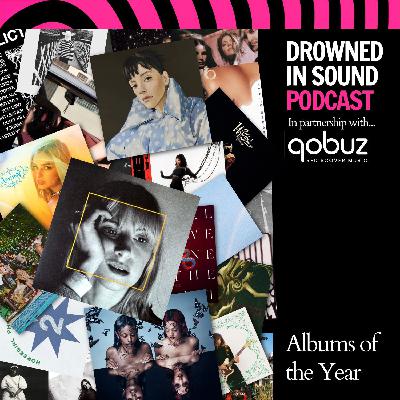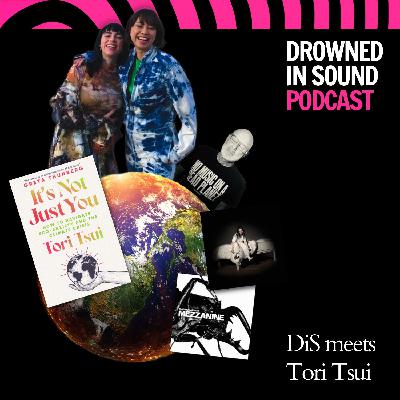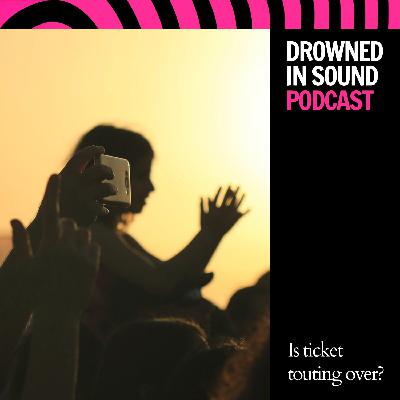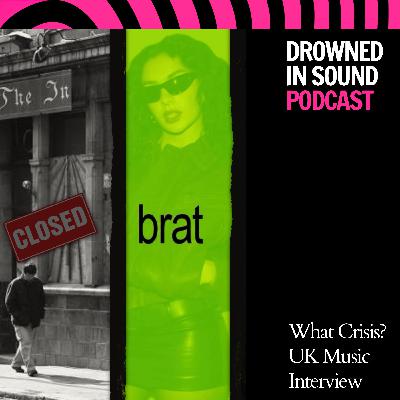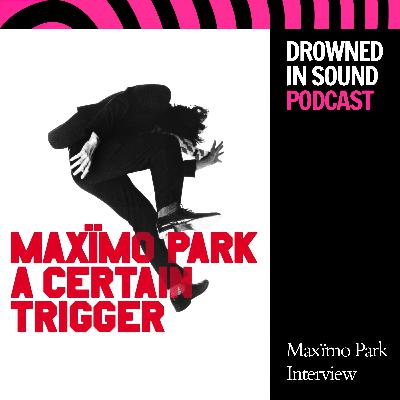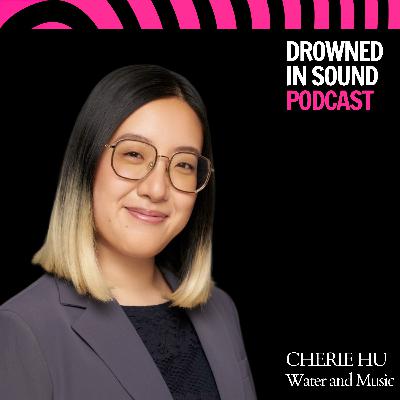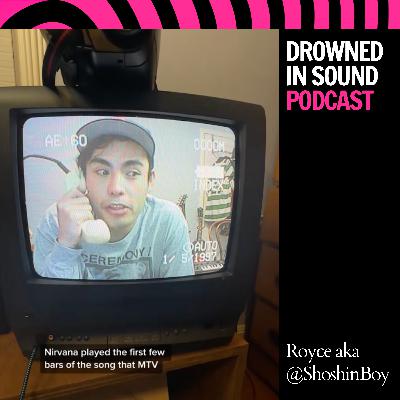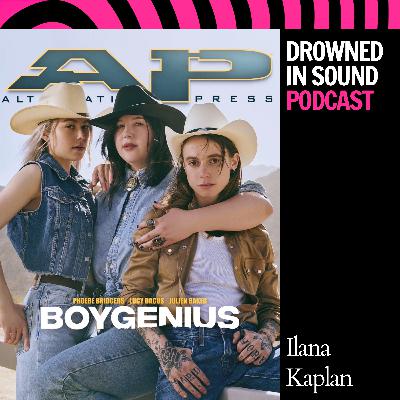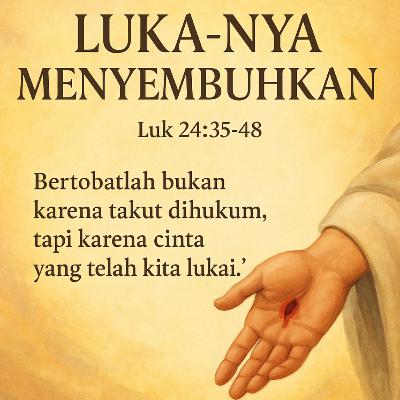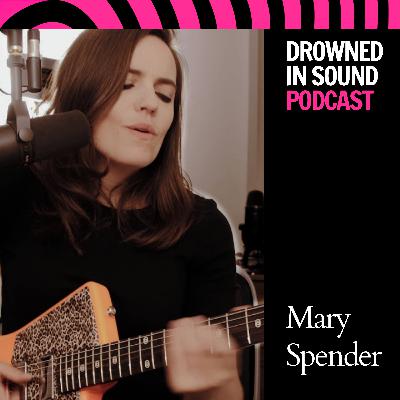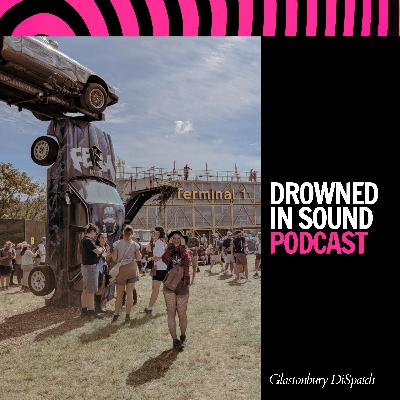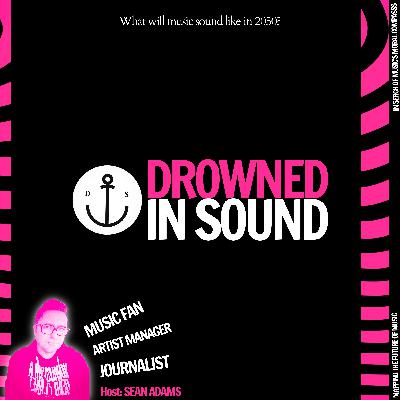Discover Drowned in Sound
Drowned in Sound

Drowned in Sound
Author: Drowned in Sound
Subscribed: 65Played: 931Subscribe
Share
© The Sounding Limited
Description
This weekly podcast explores how culture, politics, and the climate crisis are reshaping music. From AI and activism to festival futures and the collapse of local scenes, we treat music as an ecosystem, not just entertainment. Guests include artists, changemakers, and organisers reimagining what music can be. Subscribe and join the conversation.
Hosted by Sean Adams, founder of Drowned in Sound
Hosted by Sean Adams, founder of Drowned in Sound
62 Episodes
Reverse
It’s that time again: lists, arguments, consensus (or lack of it). So.. how do we choose an ultimate “Album of the Year’?
In this episode, Emma Wilkes joins Sean Adams to talk through their favourite albums of 2025. No this is not the definitive list, not the ‘right’ list, just the stuff that has stuck, been obsessed over, demanded repeat listens, or just briefly rearranged their internal wiring.
They also talk openly about the collapse of monoculture, the impossibility of ‘keeping up’, and why criticism still matters amongst the fractured scenes, algorithmic bubbles, and overwhelming volume of new music to choose from.
This is not so much a ranked list and more as two very online music obsessives trying to map a year that refuses to be summarised.
The Drowned in Sound podcast is presented in partnership with Qobuz, the pioneering high-quality music streaming and download platform for music enthusiasts and audiophiles. Each week we curate playlists on Qobuz, featuring our favourite records, artists, and the themes we explore on the show.
Visit https://drownedinsound.org/playlists/ to discover new music in rich Hi-Res lossless quality and start your 30-day free trial of Qobuz at https://qobuz.com/dis.
Chapters
00:00 – Hayley Williams and the case for a bold AOTY
01:00 – Emma’s pick: The Callous Daoboys and joyful heaviness
04:00 – Grassroots venues, noise scenes, and Atlanta’s rise
06:30 – Introducing Emma Wilkes: rock, metal & Kerrang!
09:00 – Why heavy music needs catharsis, humour, and chaos
12:00 – Hardcore’s new era and the crossover wave
14:00 – The collapse of monoculture in 2025
16:00 – Discovery fatigue and the algorithm problem
18:30 – Model/Actriz, grief albums, and theatrical noise
22:00 – Heartworms and the art of gothic storytelling
24:00 – Ska, cowbells, and unexpected nostalgia
27:00 – Honourable mentions: Lambrini Girls, Wolf Alice, Nova Twins
30:00 – Hayley Williams’ political arc and southern identity
32:00 – Easter eggs, vocal shifts, and how fans decode albums
34:00 – Allyship, perspective, and storytelling in pop
35:00 – Production notes: Efterklang, Daniel James & sonic detail
37:00 – Why music criticism still matters
39:00 – Emma’s Top 10: heavy, emotional, ambitious
42:00 – Sean’s curveballs: Postcards, DARKSIDE & more
45:00 – So… who really made Album of the Year?
Albums mentioned:
Hayley Williams - Ego Death at a Bachelorette Party
The Callous Daoboys - I Don't Want to See You in Heaven
Backxwash - Only Dust Remains
Kathryn Joseph - We Were Made Prey
FKA twigs - Eusexua Afterglow
Ethel Cain - Perverts
Model/Actriz - Pirouette
Alan Sparhawk - With Trampled by Turtles
Heartworms - Glutton for Punishment
Die Spitz ‧ Something to Consume
Little Simz - Lotus
Lily Allen - West End Girl
The Mynabirds - It's Okay To Go Back If You Keep Moving Forward
Wolf Alice - The Clearing
Turnstile - Never Enough
Addison Rae - Addison
Sharon Van Etten - Sharon Van Etten & The Attachment Theory
Marissa Nadler - New Radiations
Nova Twins - Parasites & Butterflies
Anna von Hausswolff - Iconoclasts
Sudan Archives - The BPM
Horsegirl - Phonetics On and On
JADE - THAT'S SHOWBIZ BABY!
Dave - The Boy Who Played the Harp
Garbage - Let All That We Imagine Be the Light
Scowl - Are We All Angels
Postcards - Ripe
DARKSIDE - Nothing
Jools - Violent Delights
Witch Fever - Fevereaten
Deafheaven - Lonely People with Power
Lambrini Girls - Who Let The Dogs Out
Sprints - All That Is Over
Pinkshift - Earthkeeper
Creeper - Sanguivore II: Mistress of Death
Melody’s Echo Chamber - Unclouded
HEALTH - CONFLICT DLC
Continue the Conversation:
Head to the Drowned in Sound community to chat about the topics in this episode.
Subscribe:
Get weekly essays, interviews, and insights from the Drowned in Sound newsletter - exploring music, culture, and resistance.
82% of music fans want to stop climate breakdown but only 3% know what to do. Climate activist Tori Tsui reveals how Billie Eilish, Brian Eno, and Massive Attack are building the infrastructure to turn that care into action.
Recorded backstage at EarthSonic Live in Manchester, this conversation bridges the gap between wanting to help the planet and knowing how.
Drowned in Sound founder Sean Adams meets Tori Tsui, the climate justice activist, author of "It's Not Just You," and senior advisor to the Fossil Fuel Non-Proliferation Treaty. Tori works with Brian Eno's EarthPercent and Billie Eilish's Overheated climate conferences.
IN THIS EPISODE:
• How Tori got Manchester Mayor Andy Burnham to sign the Fossil Fuel Treaty before introducing Massive Attack
• What streaming platforms are hiding about their energy use
• Why 94% of some carbon credits are phantom scams with no climate benefit
• How green touring saves artists money
• The Chris Martin/Coldplay connection
• What music fans can actually do (beyond guilt)
Organizations mentioned include:
• Fossil Fuel Treaty: https://fossilfueltreaty.org
• EarthPercent (Brian Eno): https://earthpercent.org
• Billie's Overheated: https://www.imoverheated.com
• Green touring: https://www.soliphilia.co.uk/
Read Tori's book "It's Not Just You" https://www.toritsui.com/
Follow Tori: Instagram @tori_tsui_
ABOUT DROWNED IN SOUND:
Independent music journalism exploring how music catalyzes systemic change.
Newsletter: https://drownedinsound.org
Recorded at EarthSonic Live, Manchester Museum, November 2024.
#ClimateChange #MusicIndustry #BillieEilish #BrianEno #MassiveAttack #ClimateActivism #Podcast
The UK Government have announced a landmark decision: ticket resale above face value is to be made illegal, backed by strict limits on service fees and new enforcement powers. After decades of music fans being fleeced by industrial-scale touting, could this be the turning point?
In this special episode, the FanFair Alliance’s Adam Webb (a central figure in the long-running campaign against exploitative secondary ticketing) joins Sean Adams to unpack the announcement, its implications, and what it means for fans, artists, venues, and the future of the live industry.
Webb lays out how the crisis unfolded, with resale platforms enabling huge mark-ups that now cost fans an estimated £112 million a year. They trace the steady pressure that’s been building for years: Trading Standards investigations, CMA interventions, tabloid exposés, Ed Sheeran’s court cases, and sustained evidence-gathering by managers, artists, unions, and campaigners.
Together, Adam and Sean explore the possibilities opened up by this week’s announcement and ask the simple question: what happens when fairness is restored? And will these reforms be delivered quickly enough to stop another cycle of exploitation?
Chapters:
00:00 – The scale of the problem: how industrialised touting took hold
05:10 – Viagogo, StubHub, and the ecosystem that lets abuse thrive
10:45 – The £112 million question: super-touts, bots, and business models
16:20 – Ed Sheeran, prosecutions, and the moment artists pushed back
22:40 – Why enforcement has failed — and what must change
29:15 – Politics, lobbying, and the slow road to reform
36:00 – Fans, consent, and the ethics of the live economy
41:30 – What a fair ticketing future could look like
Continue the Conversation:
Head to the Drowned in Sound community to chat about the topics in this episode.
Subscribe:
Get weekly essays, interviews, and insights from the Drowned in Sound newsletter - exploring music, culture, and resistance.
Links & Resources
Fan-Led Review of Music: Parliamentary Inquiry into Ticketing Reform
https://committees.parliament.uk/work/9161/fanled-review-of-music/
Music Fans Voice: Campaigning for Fair Ticketing and Fan Rights
https://musicfansvoice.uk/
Which? – Stop Fleecing Fans: Ending Rip-Off Ticket Resale
https://www.which.co.uk/campaigns/stop-fleecing-fans
Robert Smith: 7,000 Cure Tickets Cancelled on Secondary Sites
https://accessaa.co.uk/robert-smith-says-7000-the-cure-tickets-have-been-cancelled-on-secondary-resale-websites/
FanFair Alliance: Guide to Buying Tickets Safely
https://fanfairalliance.org/resources/
CMA Investigation: Enforcement Action on Secondary Ticketing
https://www.gov.uk/cma-cases/secondary-ticketing
STAR: The UK’s Ticketing Standards and Consumer Protection Body
https://www.star.org.uk/
Ed Sheeran’s Legal Battle Against Ticket Touts (BBC)
https://www.bbc.co.uk/news/entertainment-arts-47620979
Your Consumer Protection Rights (Gov.uk)
https://www.gov.uk/consumer-protection-rights
Adam Webb – Updates and Advocacy on Ticketing Reform
https://twitter.com/webboideas
How can the UK music industry be both in crisis and booming? In 2024, the sector was worth a record £8 billion to the UK economy but at the same time, grassroots venues are closing, artists are struggling to tour, and AI threatens to steal musicians’ work for the profit of broligarchs.
In this week’s episode, Sean Adams speaks with Tom Kiehl, CEO of UK Music, about the findings in the organisation’s brand new annual report This Is Music 2025. Together they unpack the contradictions of a sector growing on paper but straining at its foundations from slowing post-pandemic growth and the fight for fair AI regulation, to the obstacles making it harder for new artists breaking through.
With reflections on Brexit’s lasting damage, AI’s issues with consent, and a new £1 grassroots levy, it’s a revealing look at an industry at a crossroads.
Chapters
00:00 – The £8 Billion Paradox: Growth vs Crisis
03:30 – Who UK Music Represents and What It Does
07:30 – File-Sharing to AI: The Evolution of Rights Battles
13:30 – “Pro-Innovation” or Anti-Artist? AI and Copyright in 2025
18:30 – Levies, Inequality, and the Grassroots Squeeze
24:30 – Breaking Artists in a Post-Pandemic Landscape
29:30 – Rehearsal Spaces, Mentorship, and Missing Infrastructure
35:30 – Why Britain Needs a Music Export Office
41:30 – Ticketing Chaos, Regulation, and the Fan Experience
47:30 – What Fans Can Do: From Campaigns to Collective Power
52:30 – The Future of British Music: Soft Power and Survival
Continue the Conversation:
Head to the Drowned in Sound community to chat about the topics in this episode.
Subscribe:
Get weekly essays, interviews, and insights from the Drowned in Sound newsletter - exploring music, culture, and resistance.
Links & Resources:
Read UK Music’s This Is Music 2025 Report
UK Music Official Website
UK Music on Instagram
Drowned in Sound Newsletter
How “sleazy” was Indie Sleaze, really - and was it ever a scene that Paul Smith of Maxïmo Park recognised himself in?
At a time when the air was thick with lager and leather jackets, Smith was more inspired by art-school notebooks, Robert Wyatt, and the idea that pop could be poetry.
In this conversation, the Maxïmo Park frontman joins Sean Adams who also lived through the era being retrospectively called “indie sleaze”, was at those early Yeah Yeah Yeahs, Franz Ferdinand, Bloc Party and Libertines shows, released records by Metric and Kaiser Chiefs, etc.
In this conversation they revisit the making of Maxïmo Park’s Mercury-nominated debut and reflect on what it meant to be outsiders during Britain’s mid-2000s indie boom. Recorded for the album’s twentieth anniversary, the pair unpack the contradictions of that moment - art rock vs lad rock and sincerity vs posturing whilst tracing how those tensions still shape British guitar music today.
From signing to Warp Records and headlining the NME Awards Tour alongside Arctic Monkeys, Mystery Jets and We Are Scientists, to the band’s art-school roots, working-class perspectives, and enduring faith in pop’s emotional truth, this is a deeply human glance back at the legacy of one of the era’s most literate frontmen.
Chapters
00:00 – Indie Sleaze, revisionism, and the myth of 2005
01:46 – Forming an art-school band and the noise scene that shaped them
08:30 – From experimental roots to pop hooks: defining the Maxïmo Park DNA
14:30 – Signing to Warp Records and finding a home for outsiders
20:30 – The whirlwind year: Top of the Pops, the NME Tour, and the cost of success
24:30 – Art rock, class, and being mislabeled “sleazy”
31:30 – The politics of pop and the poetry of the everyday
42:30 – Romance, resistance, and the belief that pop can still mean something
Continue the Conversation:
Head to the Drowned in Sound community to chat about the topics in this episode.
Subscribe:
Sign up to the Drowned in Sound newsletter for weekly insights on music, culture, and resistance.
Links & Resources
Maxïmo Park Official Website
‘The Rise and Fall of Indie Sleaze’ - BBC Podcast
20th Anniversary Edition of A Certain Trigger
Paul Smith & Rachel Unthank Collaborative Album
Live music is nothing without the fans. Generating £5.2 billion to the UK economy PA, employing over 210,000 people and building the careers of those who contribute over £4bn to the export of live music, there is no doubting the UKs reputation as the international home of live music and the birthplace of the festival industry. Every pound of this economic success comes from a fans pocket and the House of Commons Culture Media and Sport committee have decided it’s finally time to put them in the centre of decision making, with a fan led review of Live and Electronic Music. This review aims to champion the areas that work, safeguard the areas under threat and ensure that the health and growth of live music is fair and accessible to all.
Recorded live at Sŵn Festival in Cardiff, Sean Adams introduces a special panel arranged as part of the Culture, Media and Sport Committee’s Fan-Led Review into Live Music and Electronic Music - a landmark inquiry bringing music lovers together to discuss ideas to protect the live music industry and ensure it works in the best interests of music fans across the country.
The discussion draws fascinating parallels between football and music, two cultures built on passion, loyalty, and community, yet often structured around systems that treat fans as consumers, not stakeholders.
Panellists
Chair – Sam Duckworth
With a recording artist career as Get Cape. Wear Cape. Fly spanning 20 years, Sam has most recently been working with Music Venue Trust to advocate for greater fan input into Music industry decision making, co-founding the Music Fans Voice survey.
Lord Kevin Brennan
Lord Brennan is Chair of the Fan-Led Review of Live Music, on behalf of the Culture Media and Sport Committee. The Review is bringing music lovers together to discuss ideas to protect the live and electronic music industry and ensure it works in the best interests of music fans across the country. The aim is to produce a report to the Government setting out the perspectives of fans based on survey responses, stakeholder meetings and public engagement events. Lord Brennan has held positions as a Government Minister, former Chair of the APPG on Music and was a member of the Culture, Media and Sport Committee, which produced reports on ‘The future of music festivals’ and ‘The economics of music streaming’. He is also a performing musician.
Dr Lucy Bennett – Lecturer at Cardiff University’s School of Journalism, Media and Culture
Lucy is a leading academic voice on music fandom and popular music culture. She co-founded the Fan Studies Network, has consulted for YouTube, and delivered analysis for the Recording Academy/Grammys. Widely published, she also provides expert commentary for the BBC, The Guardian and The Washington Post. Her teaching spans Media Fandom and Popular Music, Media & Culture, and she recently worked on the Music Fans’ Voice Survey, amplifying live music audiences.
Cathy Long – CEO of Aposto
Having worked with 64 football clubs at the Premier League (spearheading safety and fan experience) , The FSA and co-author of the Accessible Stadia Guide, Cathy is one of English Football’s leading fan experts and a passionate and experienced advocate for Equality and Safety within the game.
Julian Jenkins
Julian Jenkins is a seasoned sports executive and entrepreneur with over 25 years of experience in the global sports industry. He has held senior leadership roles across football, licensing, and commercial development, helping to grow fan engagement, brand value, and international partnerships. Julian now lead multiple ventures spanning professional women’s football, AI-driven sports analytics, and creative IP development, blending his passion for sport, community, and innovation. His work focuses on building sustainable models that connect clubs, fans, and brands in more meaningful ways.
Continue the Conversation:
Head to the Drowned in Sound community to chat about the topics in this episode.
Subscribe:
Sign up to the Drowned in Sound newsletter for weekly insights on music, culture, and resistance.
Further Reading
Fill in the fan-led review of Live & Electronic Music survey
Music Fan’s Voice Survey
The Fan Led Review of Live Music – UK Parliament CMS Committee
Football Supporters’ Association
What happens when the tech platforms care more about engagement and profits than music?
DiS meets music & technology journalist Cherie Hu, the founder of Water & Music, who's spent years mapping how tech giants from Spotify's recommendation algorithms to the venture capital funding streaming platforms. She's built one of music's most essential research operations to help fans and artists understand who really benefits from the current system and how best to use the tech of tomorrow..
Chapters
00:00 – Introduction
03:20 – Defining practical futurism and collaborative research
05:40 – From Forbes freelancer to community builder
07:55 – The evolution of Water & Music's collaborative model
12:40 – What collaboration enables now vs. the past
17:25 – Music and media's parallel challenge
22:15 – Building relationships and networks in the attention economy
23:50 – Domain specialisation vs. generalist approach in a noisy media landscape
29:20 – Artists and founders engaging with Water & Music
31:40 – Evergreen content, catalog lessons, and growth strategies
37:25 – Community building fundamentals: patience, trust, and institutional memory
40:05 – Math, music, and creativity
42:10 – Defining what community means
43:30 – Sean's Outro
Join the discussion in our community
Subscribe to DiS newsletter
Guest Links:
Water & Music - Independent music industry research
Cherie Hu
About the Host:
Sean Adams is the founder of Drowned in Sound, championing independent music since 2000. Through DiS, he maps music's future while supporting artists and fans building alternatives to platform control.
Nirvana, TikTok, analogue aesthetics, and virality don't usually go together. Meet the creator who is bucking all the trends.
How do you build genuine community around music in an attention economy designed for extraction? What happens when Nirvana's DIY punk ethics meets TikTok algorithms? Can analog aesthetics and primary source research create alternatives to clickbait culture?
This week, Drowned in Sound founder Sean Adams talks with Royce aka ShoshinBoy - the TikTok creator behind viral music history videos that blend VHS cameras, rotary phones, and deep cultural excavation. From viral Nirvana content (2 million views) to uncovering forgotten Cure folklore, his analog-meets-digital approach reveals how authentic passion can cut through algorithmic noise.
Inspired by DIY punk rock culture, ShoshinBoy developed research methodology that prioritises primary sources and contemporary context over Wikipedia aggregation. His anti-gimmick gimmick - talking through vintage technology while analysing YouTube clips of Arctic Monkeys, The Clash, Pavement and many more - started as platform critique but evolved into genuine community building around shared musical mythology.
The conversation explores creator economy extraction, the death of mysterious rockstars in parasocial media landscapes, and why nostalgia both preserves and destroys cultural memory. Most importantly, it reveals how DIY ethics can survive on corporate platforms when creators prioritise community service over algorithmic optimisation.
Chapters:
00:00 – Introduction
04:30 – Defining journalism
08:37 – Everett True's book to TikTok virality
11:59 – The analog setup: Anti-gimmick philosophy
17:05 – Primary sources vs Wikipedia
24:11 – Creator economy critique
34:04 – Nostalgia as cultural force
42:15 – Alternative funding
45:04 – The future of musical mythology in algorithm-driven culture
Quotable Moments:
"I think that like. At its core, I just wanna be genuine and, and like I said, I'm only doing this 'cause it's fun and it's what I'm compelled to do anyways." [24:00]
"I don't think the idea of selling out exists in the year 2023. Acknowledging the idea that just to even pay rent or, or exist as a creative online in the current economy is, is it's so difficult." [26:00]
Continue the Conversation:
Email sean@drownedinsound.org with your thoughts on DIY ethics in the creator economy
Join the discussion in our community forum about preserving musical mythology
Share your experiences building authentic community around music passion
Guest Links:
@shoshinboy on TikTok - Analog music history through VHS and telephone
Shoshin Boy on Instagram
Referenced in Episode:
Everett True – Live Through This: American Rock In The 90s - The story of the grunge phenomenon by Everett True
Careless Talk Costs Lives Magazine - Everett True's magazine mentioned
Meta Label - Yancy Strickler's collective-focused creative platform
Artist Corps - Creative collective experiment mentioned
Simon Reynolds - Retromania - Book on nostalgia culture referenced
About the Host:
Sean Adams is the founder of Drowned in Sound, an independent music publication that has championed underground and independent artists since 2000. Through the DiS podcast, newsletter, and community, Sean explores how to build a fairer, more sustainable music industry while supporting the artists and fans who make it meaningful.
This evergreen episode of the DiS podcast was recorded in 2023 and explores how DIY punk ethics can survive and thrive in platform capitalism, revealing alternative paths for creators who prioritise community building over algorithmic extraction in the attention economy.
How do music journalists spot breakthrough artists before they become household names? What does it take to get leftfield artists like Zola Jesus into mainstream publications like Vogue? How can music journalists build trust that transforms both interviews and careers?
This week, Drowned in Sound founder Sean Adams talks with Ilana Kaplan - the music editor at People Magazine and author of "Nora Ephron at the Movies" (Abrams Books, 2024). Following conversations about discovery and algorithms, this episode explores the craft of music journalism: how experienced writers develop taste, build industry relationships, and create the stories that shape how we discover music.
From researching artists at the Barnes & Noble magazine racks to recognising Billie Eilish's potential at a Mercury Lounge show to creating the viral boygenius Brokeback Mountain-inspired cover stories for Alternative Press, Ilana's career journey reveals the human curation that algorithms can't replicate.
The conversation covers discovery methods, editorial strategy, the changing definition of "alternative music," and why building trust with artists creates better journalism than aggressive questioning.
Chapters:
00:00 – Introduction
04:30 – What journalism means in the misinformation age
08:37 – Ilana's career beginnings from SPIN intern to music obsessive
11:59 – Spotting stars early: the Billie Eilish gamble that paid off
17:05 – Getting Zola Jesus into Vogue: selling leftfield artists to mainstream editors
24:11 – What does 'alternative' actually mean?
25:07 – boygenius desert shoot: spending your own money for viral covers
34:04 – Blacklisted for honest reporting: when PR controls journalism
45:04 – The hope in innovation and how models are changing
53:22 – Sean's Outro
Key Takeaways:
Discovery requires human curation: The Hype Machine's organic blog aggregation created an outlet for excitement that algorithms can't replicate
Trust transforms journalism: Giving artists space to be heard reveals more than aggressive questioning
Editorial bridges build community: Getting Zola Jesus into Vogue shows how to connect leftfield artists with mainstream audiences
Investment creates lasting impact: The boygenius desert cover succeeded because someone fought for the vision and funded it personally
Taste-making is community service: Early discovery of artists like Billie Eilish demonstrates journalism's role in cultural development
Continue the Conversation:
Email sean@drownedinsound.org with your thoughts on music journalism's craft
Join the discussion in our community forum
Guest Links:
Nora Ephron at the Movies - Ilana's book published October 2024
@lanikaps on Twitter
@lanikaps on Instagram
Ilana on Bluesky
Referenced in Episode:
Defector - Writer-owned sports publication mentioned as model
The Hype Machine - Music blog aggregator that shaped early 2010s discovery
Rob Sheffield at Rolling Stone - The writer who inspired Ilana's career
boygenius in AltPress - The cover feature we discuss
The Future Is Written - Huck Magazine profile mentioned in outro
About the Host:
Sean Adams is the founder of Drowned in Sound, an independent music publication that has championed underground and independent artists since 2000. Through the DiS podcast, newsletter, and community, Sean explores how to build a fairer, more sustainable music industry while supporting the artists and fans who make it meaningful.
This episode was recorded in November 2023 during Ilana's transition between staff and freelance work, capturing insights about journalism craft and industry navigation during a period of significant media industry change.
In this special Q&A episode, DiS founder Sean Adams explores the uncomfortable truths about streaming economics, social media burnout, and why the music industry's success metrics are fundamentally broken.
From debunking the myth that millions of streams equal financial stability to reframing social media as an extension of artistic practice, Sean answers your questions and offers practical wisdom for navigating an industry designed to exploit rather than support creators.
This episode strips away the glossy veneer of streaming success stories to reveal the harsh mathematical reality: an artist with 25 million streams over a decade might earn just £6,000 annually - less than minimum wage, before expenses. Sean explores why massive streaming numbers rarely translate to sustainable live audiences and how platforms like Spotify actively prevent artists from connecting with their own listeners.
Timestamped Chapters:
[00:00] Introduction
[01:31] What do you tell an artist that has great music but hates social media?
[09:46] What will streaming look like in five years?
[14:57] Is there still a place for live streaming gigs?
[20:37] Does 25 million Spotify streams pay enough to live on?
[27:07] The difference between building a fanbase and streaming numbers
[32:35] Outro and preview for Part 2
[34:01] Bonus track: Kate Nash on MySpace
Key Takeaways:
How to transform social media from promotional burden into artistic storytelling extension
Recognise the disconnect between streaming numbers and actual audience connection
Focus on platforms that enable direct fan communication rather than vanity metrics
Consider live streaming only for performances designed specifically for digital consumption
Resources Mentioned:
Mood Machine: The Rise of Spotify and the Costs of the Perfect Playlist by Liz Pelly
Benefits' meta-commentary social media approach
Moment House platform for curated live streaming
Bandcamp for Artists - Direct fan communication model
Bandcamp Community Features - Artist-to-fan messaging
Questions Answered:
Sarah Howells (LinkedIn): Advice for great artists who hate social media
Mark Painting (LinkedIn): Will streaming consolidate or fragment in five years?
Paul Gaffigan (Email): Is there still a place for live streaming post-lockdown?
Tony Moss (Email): Breaking down the 25 million streams success myth
Continue the Conversation:
Send your questions for future Q&A episodes to sean@drownedinsound.org or find Sean online. What music industry myths need debunking next?
About the Host:
Sean Adams is the founder of Drowned in Sound, an independent music publication that has championed underground and independent artists since 2000. Through the DiS podcast, newsletter, and community, Sean explores how to build a fairer, more sustainable music industry while supporting the artists and fans who make it meaningful.
Next Episode Preview:
Part two continues with Sean's analysis of the Disarmed Spotify movement - why musicians are pulling their music and fans are abandoning the platform they once trusted.
What if the very thing that makes you feel like an outsider in the music industry could become your greatest business advantage? How do you build something meaningful when you're convinced you're not qualified? And why might starting before you feel "ready" be the secret to creating lasting change?
This week, Sean talks with Isobel Anderson - founder of Girls Twiddling Knobs, one of music tech's most important feminist voices. Following on from the Mary Spender episode about converting online reach into sustainable income, this conversation explores a different path: how small, mission-driven businesses can create industry change without needing massive audiences.
From a PhD in Sonic Arts to over 25 million Spotify streams to building Girls Twiddling Knobs into one of music tech's most important feminist voices, reaching thousands of women through courses, community, and her acclaimed podcast, Isobel's journey proves that feeling like an imposter might actually be your qualification.
In essence, this episode is about turning industry frustrations into business opportunities, why multiple revenue streams are now reality for musicians, and how to value your work when the world expects creativity for free.
Chapters:
00:00 – Sean's Introduction: Building Your Independent Music Business
02:41 – Isobel Anderson intro: From Singer-Songwriter to Sonic Arts PhD
08:12 – Why Sound Design and Production Details Matter
10:08 – Confronting Misogyny in the Music Industry
20:05 – From Facebook Group to Girls Twiddling Knobs
24:41 – Overcoming Self-Doubt When Learning Something New
30:46 – Why Great Producers Are More Than Technical Experts
33:48 – Valuing Your Work and Putting a Price on Creativity
46:40 – Are Musicians as Vital to Society as Doctors?
49:37 – Balancing Music-Making with Building a Business
55:54 – Sean's Outro Reflections
Key Takeaways:
The 10% Edge: You don't need to be an expert to start teaching others - you just need to be one step ahead of the people you want to help.
Start Before You're Ready: "You are not going to ever be ready to do this" - perfectionism is the enemy of progress.
Mission Before Money: Purpose-driven businesses can be more disruptive than charities because they can make quick decisions and restructure rapidly.
Multiple Revenue Streams Are Reality: Modern music careers require diversified income - it's not a backup plan, it's the plan.
Community Over Confidence: Building safe learning spaces can be more valuable than traditional "confidence training."
Continue the Conversation:
Email sean@drownedinsound.org with your thoughts
Join the discussion: Drowned in Sound Community
Get more music insights: DiS Newsletter
Guest Links:
Girls Twiddling Knobs Podcast
Isobel Anderson - Artist
Referenced in Episode:
The Anchoress - Artist managed by Sean
Girls Twiddling Knobs special episode - The immersive episode Sean references
Delia Derbyshire Day - Celebrating the electronic music pioneer
The Oram Awards - Recognizing women innovating in music and sound technology
About the Host:
Sean Adams is the founder of Drowned in Sound and manages artists including Charlotte Church and The Anchoress. Beyond founding one of the original music blogs, he's worked with BBC 6 Music and co-produced political podcast The Trawl. Through the DiS podcast, he maps the future of music by exploring culture, politics, and the systems shaping how we create and consume music.
Note: This conversation originally took place a couple of years ago but feels more relevant than ever as musicians navigate the realities of building sustainable, independent careers. If this episode sparks any business ideas, we'd love to hear about them in three years' time.
While most music industry coverage focuses on (poly)crisis and collapse, Mary Spender argues we're living through the greatest era for independent artists in history.
But, but but... what about streaming economics, venue closures, and platform dependence? Don't worry, we get into it.
With over 100 million YouTube views, 34,000 newsletter subscribers, and significant album sales achieved before releasing a single track to streaming, Mary demonstrates there are viable alternatives to industry doom-spiralling.
In this conversation, she reveals her strategies for converting YouTube viewers into album buyers, why artists need to think like entrepreneurs, and what she'd build with Spotify's $400 million Joe Rogan budget.
Sean also asks her about her recent video about why artists should embrace YouTube. Speaking of which, you will be able to see clips from this interview over on Drowned in Sound's YouTube: youtube.com/@DrownedinSound
Timestamps
00:00 Sean's Intro
03:21 What will music be like in 2050?
06:25 Why artists should think like entrepreneurs
12:45 What does the future hold for independent artists?
16:56 The 1000 true fan theory
18:51 Should YouTube be the #1 platform for musicians?
24:36 Researching with an open mind. A rare skillset?
29:45 How to convert an audience from YouTube
34:17 What can the UK government do for music?
36:35 How would Mary spend the $400 million Spotify paid Joe Rogan?
38:39 Is long-form content on the return?
43:29 Sean's Outro
Quotable Moments
"Technically it's never been a better time to be a musician than today, even though everyone likes to talk about the heyday. But that was for a very lucky few."
"If you don't have the grassroots, you don't have the artists in Wembley Stadium. Like you don't have that trajectory."
Continue the Conversation📧 Email sean@drownedinsound.org with your questions for future episodes🌐 Join the Drowned in Sound Community📰 Subscribe to the Drowned in Sound newsletter
Guest Links
Mary Spender's YouTube Channel
Mary's website and newsletter
The Dire Straits Documentary on Nebula
Referenced in Episode
Kevin Kelly's "1000 True Fans" essay
About the Host: Sean Adams is the founder of Drowned in Sound (est. 2000), manages artists including Charlotte Church and The Anchoress, and has worked with BBC 6 Music. Through this podcast, he maps the future of music by exploring culture, politics, and the systems shaping how we create and consume music. At its peak, Drowned in Sound had over 3 million readers. Stay tuned for details about its 25th anniversary celebrations.
What does it feel like to attend Glastonbury for the first time?
Music journalist Emma Wilkes brings us along for her debut pilgrimage to the UK's landmark musical gathering. She spins us a sonic diary with interviews from Terminal 1 and Laima Layton, along with reactions to some of the politically charged moments of the festival (shouts to Amyl and the Sniffers).
Along the way, there are vox pops with strangers, overlooked corners, and moments that slipped under the mainstream radar…
00:00 Introduction
01:51 Pre-festival preparation with Emma Wilkes
03:26 Attendees' expectations of Glastonbury 2025
04:22 First impressions and Thursday observations
06:19 Terminal 1 and an interview with Laima Layton
18:32 The sounds of Worthy Farm
19:12 How does the real-life festival compare to the coverage seen previously?
21:45 The political moments of Glastonbury 2025
30:42 The journey home, the Tuesday after, and a summary from a slightly raspy Emma
34:11 Expectations vs. reality with the people of the festival
Mentioned in the episode:
Laima Layton
In Place Of War
GRRRL
Terminal 1
Amyl and the Sniffers
JADE
Seun Kuti
Maruja
Lambrini Girls
Join the conversation: Drowned in Sound Community
Email: sean@drownedinsound.org
Stay updated: Subscribe to DiS newsletter
How do you build genuine community when algorithms reward viral moments over real connection? What if sustainable music careers start with just five super fans rather than chasing millions of followers?
Drowned in Sound founder & artist manager Sean Adams speaks with Nikki Camilleri - music strategist, Forbes 30 Under 30 honoree, and founder of mana - about the ground-level realities of building a music career in 2025.
From growing up in Malta and navigating geographic disadvantage to working with breakthrough artists like Cat Burns, Nikki breaks down what actually works in today's oversaturated landscape.
This conversation digs deep into authentic community-building versus audience accumulation, the "five super fans" principle that challenges conventional wisdom, and why most artist advice around social media is fundamentally broken.
Plus: Nikki's vision for fixing music industry infrastructure by 2050, including transparency tools and direct fan connection platforms that don't rely on algorithmic gatekeepers.
"You need five super fans to start getting going - that's equal to about 250 passive fans. When you start looking at it that way, it doesn't seem as daunting."
— Nikki Camilleri on why quality beats quantity in fan building
Episode Timestamps:
00:00 Introduction: Music Reality Check for 2025
02:03 Envisioning Music in 2050: Transparency and Infrastructure
04:34 The Malta Factor: Geographic Disadvantage in Digital Times
08:26 The Resilience Crisis: From "Ready to Fight" to Viral Expectations
16:28 Five Super Fans vs Viral Algorithms: Quality Over Quantity
20:14 Real Community vs Audience: Building Genuine Connection
32:15 Artist Purpose and Identity: The "Horror Electronica" Story
39:21 Fixing the Industry: Where Would You Spend Spotify's Money?
44:48 Key Takeaways: What Actually Works
Mentioned in the episode:
Nikki Camilleri
ROSTR
Royal Society of Arts
Volt.fm
Kat Abu
The Anchoress
Kevin Kelly on 1000 True Fans
Join the conversation: Drowned in Sound Community
Email podcasts@drownedinsound.org
Subscribe to DiS newsletter
What does it mean to “metabolize” emotion through music? Do wellness tools actually work better when paired with your favourite artist? Why does the music industry treat artists like products and not caregivers?
Drowned in Sound founder Sean Adams is joined by Ariana Alexander-Sefre, co-founder of the mental health app SPOKE, to talk about the future of therapy and how music can play a pivotal role in that. The conversation explores the science behind sound, the emotional toll on musicians, and why music should be taken seriously as a public health tool.
Spoke has worked with over 100 artists, training them in techniques like CBT and mindfulness to embed into lyrics and melodies - and the results are changing lives.
Episode chapters:
0:00 - 2:45 - Introduction
2:46 - 4:55 What would Ariana hope music to be like in 2050?
4:56 - 7:46 Using music to “metabolize” emotions
7:47 - 11:50 Who are SPOKE and who is Ariana Alexandre-Sefre
11:51 - 13:42 The relationship between music and mental health
13:43 - 20:28 Inside the SPOKE app - embedding music with culture with therapy
20:29 - 31:18 Why the music industry needs a fresh perspective on artist value
31:19 - 37:08 The science behind functional music and mindfulness
38:09 - 40:04 The real-world impact of therapy delivered through music
40:05 - 48:08 Can artists become a recognised part of healthcare?
48:09 - 54:13 - Closing thoughts from Sean
Mentioned in the episode:
Music Minds Matter
Can Music Make You Sick? (Sally Anne Gross)
Mood Machine: The Rise of Spotify and the Cost of the Perfect Playlist (Liz Pelly)
Endel
Join the conversation: Drowned in Sound Community
Email: sean@drownedinsound.org
Subscribe to DiS newsletter
What does a melting glacier sound like? Can a rainforest sing? And what happens when the last bird of its species hears a recording and tries to reply?
In this special live edition of the Drowned in Sound Podcast, recorded at Tallinn Music Week, host Sean Adams moderates a powerful conversation on music, ecology, and collective action. Joined by artists and innovators from the EarthSonic project, the panel explores how field recordings, plant biofeedback, and immersive sound can shift our understanding of the planet — and why that emotional shift matters.
From Brazil’s disappearing biodiversity to sound fossils in the Swiss Alps, this episode weaves together music, activism, and indigenous wisdom in an urgent yet hopeful conversation about art’s role in averting climate collapse.
Plus Ruth from In Place of War reveals their new project with Bicep in Greenland that launches in summer 2025.
Featured Guests & Projects:
Natural Symphony (Joey Dean)
Ludwig Berger
In Place of War / EarthSonic (Ruth Daniel)
Martyn Ware (Heaven 17 / Human League)
Episode Highlights & Timestamps:
03:00 – Ruth Daniel on the origins of In Place of War and EarthSonic
06:00 – Ludwig Berger: Listening to melting glaciers through hydrophones
11:00 – Martyn Ware (Heaven 17/The Human League) on sonifying endangered species and synthetic forests
17:00 – Natural Symphony: Collaborating with plants and reforesting the Amazon
27:00 – The power of sound to bridge disconnection and inspire action
33:00 – Building cultural change through art and emotional resonance
39:00 – Sound healing, deep listening, and making the unseen audible
45:00 – What capitalism doesn’t want us to feel — and why art matters
52:00 – Indigenous wisdom, urban detachment, and finding your own tree
58:00 – Hopeful projects, collective agency, and calling in the music industry
Mentioned in the Episode:
"The Last Scream" new release
Crying Glacier movie
EarthSonic panel replay via the TMW.EE website
Join the Conversation:
Drowned in Sound Community
Email Sean → sean@drownedinsound.org
Follow Sean on Bluesky
Subscribe to the DiS Newsletter
What did the future sound like when the synthesizer first arrived? What does it feel like now, with AI looming and immersive audio spaces on the rise?
In this special episode of the Drowned in Sound Podcast, recorded at Tallinn Music Week, Sean Adams speaks with Martyn Ware — founder of The Human League and Heaven 17, producer for acts ranging from Tina Turner to Erasure, and creator of some of the UK’s most ambitious sound installations.
This is a conversation about optimism and dystopia, about punk and purpose, and about how DIY culture in Sheffield shaped a career that’s still future-facing today.
Martyn also reflects on his podcast Electronically Yours, the legacy of sound, and how creative freedom can reshape confidence, community, and cultural memory.
Timestamps & Topics:
01:32 – Synths, Sheffield, and starting out
07:00 – Curiosity and creative confidence
10:00 – From charts to immersive installations
14:30 – Podcasting and preserving legacy
20:00 – What would a Martyn Ware bar sound like?
25:00 – Optimism, memory, and what comes next
Further Listening & Resources:
🎙️ Electronically Yours podcast
🔊 Illustrious Company (immersive audio)
🧠 Sounds of Our Shores installation
Stay Connected:
🗣 Drowned in Sound Community
📩 Email Sean → sean@drownedinsound.org
🔵 Follow Sean on Bluesky
📰 Subscribe to the DiS Newsletter
About the Guest:
Martyn Ware is a pioneering British musician, producer, and sound artist. As a founding member of The Human League and Heaven 17, and co-founder of British Electric Foundation, he helped define the sound of synth-pop while pushing boundaries in spatial audio, immersive installations, and political music-making. He also hosts the acclaimed podcast Electronically Yours.
About the Host:
Sean Adams turned his passion for music into Drowned in Sound, a UK-based music platform that launched in 2000. He also manages artists like Charlotte Church and The Anchoress, and works across strategic communications in the music and creative sectors.
What's it like to be an artist right now? And what does the future of music look like? Will it be AI-generated slop or a joyful return to community and creativity?
In this episode of the Drowned in Sound Podcast, Sean Adams speaks to Becky Hawley from the art-pop trio Stealing Sheep.
From the launch of their new label G-IRL (Girl In Real Life) to their reflections on DIY culture, Liverpool’s music scene, and 15 years of creative evolution, this episode is full of inspiring insights about building something real in a digital world. Expect discussion of Daft Punk, community over algorithms, mechanical bulls, offline joy, and what it really means to be a band in 2025.
📌 Key Timestamps:
00:00 – Intro & New Album Campaign
01:56 – What Will Music Be Like in 2050?
04:54 – Joy, Fears, and Creative Challenges
07:19 – The Sound of Stealing Sheep: Riding the Bull of Tech
10:37 – G-IRL: Launching Their Own Record Label
20:33 – Liverpool as Inspiration & Music City
25:23 – Album Campaign Concepts & Offline Joy
29:18 – Let’s Go! New Single & Album Themes
30:59 – Artistic Identity, Collaborations & Creative Growth
33:50 – Lessons Learned from 15 Years in Music
38:05 – Building Community, Offline Spaces, & Human Connection
42:57 – Supporting Grassroots Scenes
49:01 – AI, Future Tech & Music’s Utopian Possibilities
52:21 – Final Reflections: What Artists Need to Unlearn
Links
New Single “Let’s Go”
Watch the Music Video
Tatty Devine Collab
Guerrilla Girls
Join the Conversation:
🗣 Drowned in Sound Community
📩 Email Sean → sean@drownedinsound.org
🔵 Follow on Bluesky
About the Guest:
Becky Hawley is one-third of Stealing Sheep, a Liverpool-based band known for their innovative, genre-defying sound. The trio recently launched their own record label, G-IRL (Girl In Real Life), to support their own work and that of other boundary-pushing creatives.
About the Host:
Sean Adams is the founder of Drowned in Sound, a pioneering music webzine launched in 2000. He also manages artists like Charlotte Church and The Anchoress, and works across campaigns that support independent and ethical approaches to music and media.
A conversation about Fresh Hell, subcultures in nature, and shifting the climate narrative through creativity.
In this episode of the podcast that maps what music will be like in 2050 by meeting cultural changemakers and pioneers, Sean Adams explores how the Fresh Hell zine - a collaboration between creatives from the agency Iris and Purpose Disruptors (download it here) - reframes our relationship with nature through goth culture, beauty, and imagination.
Featuring clips from Freya Beer’s special Gothic Disco radio broadcast recorded at Walthamstow Wetlands (listen to it on Mixcloud here), featuring reflections from Lira Valencia and Chris Packham, which inspired the zine, we explore what happens when goth culture meets the natural world.
This conversation with Purpose Disruptors who run the Agency for Nature & the creators of Fresh Hell zine, examines how creativity can help us move from awe of the natural world to cultural transformation—and what musicians, media, and fans can do to help shift the climate crisis narrative.
Aimee Brewerton – Comms & Engagement Manager at Purpose Disruptors, working across climate-focused storytelling, brand strategy, and cultural transformation.
Nicole Vanner – Designer at Iris, co-creator of Fresh Hell, blending gothic subculture with natural aesthetics in visual communication.
Andrew Hadley – Copywriter at Iris, co-author of Fresh Hell, exploring language that rewilds desire and reframes our connection to nature.
Purpose Disruptors – A UK-based network of 5,000+ creative professionals transforming the advertising industry to align with climate goals and societal well-being.
Iris – A global creative agency known for working with progressive brands and championing purpose-driven campaigns.
Agency for Nature – A project platform by Purpose Disruptors that reimagines communications through a regenerative, nature-first lens — including campaigns like Fresh Hell.
Episode Summary & Timestamps:
00:00 Introduction: Can Music Change the Climate Conversation?
00:31 Exploring the Goths in Nature Project
01:23 Meeting the Change Makers
04:20 Chris Packham's Punk and Nature Connection
06:52 The Future of Our Planet in 2050
11:27 Purpose Disruptors: Changing the Advertising Narrative
14:17 Creating the Goths in Nature Magazine
25:09 The Role of Nature in Mental Health
30:01 Spotting the Moor Hen
30:52 Goth Music and Personal Favorites
31:20 From Radio Show to Zine
32:44 Chris Packham's Contribution
35:04 Celebrating Nature and Subculture
38:49 Nature as a Client
40:00 Collaborative Efforts and Creative Freedom
48:01 Impact and Mindset Shift
58:39 Future Hopes and Accountability
01:08:32 Final Thoughts and Call to Action
Featured Links & Resources:
Fresh Hell Zine
Purpose Disruptors
Freya Beer’s Gothic Disco
Lira Valencia (Instagram)
Bird Nerdeem (Instagram)
Freya Beer (Instagram)
Agency for Nature
Walthamstow Wetlands
Lawyers for Nature
Earth Percent
Creatives for Climate
Good Life 2030 short film
Songs Mentioned:
Something to Remember Me By – The Horrors
This Corrosion – Sisters of Mercy
Soundtrack to previous episodes by Sound Mirror now available on Bandcamp
Join the Conversation:
Drowned in Sound Community
Email: sean@drownedinsound.org
Follow on Bluesky
Upgrade to support my work:
Subscribe to the Drowned in Sound newsletter
Drowned in Sound founder and DiS podcast host, Sean Adams answers your questions. Send Qs for future episodes to sean@drownedinsound.org.
Links mentioned in this episode
Article: Cafe Oto at Oscars - The Guardian
Artist Recommendation: Nina Versyp
Artist Recommendation: TTSSFU
Artist Recommendation: Maella
Video: Apple on Dolby Atmos
Ticket App: Dice
Link: Tim Burgess listening party
Article: Bjork immersive album Bowers + Wilkins
Drink: Icelandic drink Black Death
Venue Recommendation: Trades Club in Hebden Bridge
Music by Sound Mirror, available on Bandcamp here: https://sound-mirror.bandcamp.com/album/lake-wind-water-mountain
Your Questions:
Alex Lee Thompson: Are ”scenes” over? Unpack that question as you like
Simon Marshall: After the excellent live bands to look out for article, sponsored by Seetickets, I would be interested in your views on the ticket selling part of the music industry - as a music consumer the DICE app was and is a revelation, what is your experience, and what is the best place to buy to support artists and venues?
Ear Protect Req: What three bands or artists should we be checking out live?
Soundmirrorworld: Will the Atmos, immersive audio bubble burst? Or keep going ’til we’re full frontal?
Alex Botten: What do you think about the hoards of zombie cover bands eating up local venues. Are they helping or hurting the scene? (I believe profoundly hurting)
Eric Weiner: Would love to hear your thoughts on the listening party. Are they ever any good? What’s the perfect album release party?
Grimes quote in full: Honestly the thing I like most about k pop is its an actual scene - reminds me Canadian punk scenes or the indie scene back in the day where like if your integrated enough there's like a constant feed of beauty with sort of known rituals, built in community, and like a collective excitement that is contagious and life affirming. I see how music scenes function effectively as a quasi religious institutions in a secular society. The extreme corporatization of music followed by Covid was very culturally harmful imo cuz a healthy modern music scene is actually a functional religious replacement - if one assumes the mind is better served by access to a healthy community that produces art, has events, shared morality and values, messiahs haha etc. Techno and emo rap similarly ensnared me over the last decade to an extent but they seem less "all ages"


